The Teenage Mutant Ninja Turtles revival is in full swing. Shredder’s Revenge was a GotY contender in 2022, and Mutant Mayhem is one of the best Hollywood blockbusters of the year in an otherwise crowded field. So it’s a good time to revisit the crime-fighting ninjas’ best video game outings while we patiently wait for the next one.
TMNT’s video game adaptations have been a wild roller coaster ride, from the highs of the best arcade brawlers to the lows of late-2000s movie and cartoon tie-ins. We’ve been on a recent upswing, but the history of the franchise is littered with boring and busted cash-grabs, as well as a few ideas that looked great on paper (PlatinumGames’ Mutants in Manhattan) but failed miserably in action.
Fortunately, you can play many of the best TMNT classics with complete retro fidelity and modern quality-of-life settings via last year’s excellent The Cowabunga Collection. Then you can decide for yourself which is better in the OG console warrior battleground of Turtles in Time vs. The Hyperstone Heist. In the meantime, here are the best TMNT games across the ages, in no particular order, according to the staff at Kotaku.
Teenage Mutant Ninja Turtles (Arcade)

Play it on: Arcade, Xbox 360, Cowabunga Collection
The original arcade game that made the Turtles bonafide video game superstars. Leo, Raph and the rest practically felt predestined for this. Four characters, each with their own signature weapon? Hell yeah, just make a video game for up to four players where you get to play as each of them and crack some Foot Clan skulls.
It was a recipe for success, one that you could even argue would be hard to screw up, but Konami took that concept and made it sing. The action was approachable—anyone could feed the game a few quarters and have some fun mashing buttons, though it rewarded skill as well, and teaming up with friends to take down familiar foes like Bebop and Rocksteady felt great.
But perhaps most remarkable was how the game looked, as vibrant as the cartoon itself. This was an era in which arcade games were visually improving at an astounding rate, but even among the other offerings of 1989, TMNT was a knockout. “It looks like the cartoon!” I remember classmates exclaiming during recess.
And yet, for many, the impact of this game was most keenly felt outside of the arcade. In 1990, the game got an NES port. Sure, it didn’t look nearly as good, and yeah, you could only play with up to two players, but it was still a total blast. Certainly my fondest memories of the game are of being crowded around a TV set with a friend and some ‘za. (Hey, it came with a coupon for a free personal pan pizza from Pizza Hut!) Whether played at home or in its natural arcade habitat, the original TMNT arcade brawler was a masterpiece of adaptation, perfectly capturing the intrinsic appeal of the property on which it was based. — Carolyn Petit
Teenage Mutant Ninja Turtles III: Radical Rescue
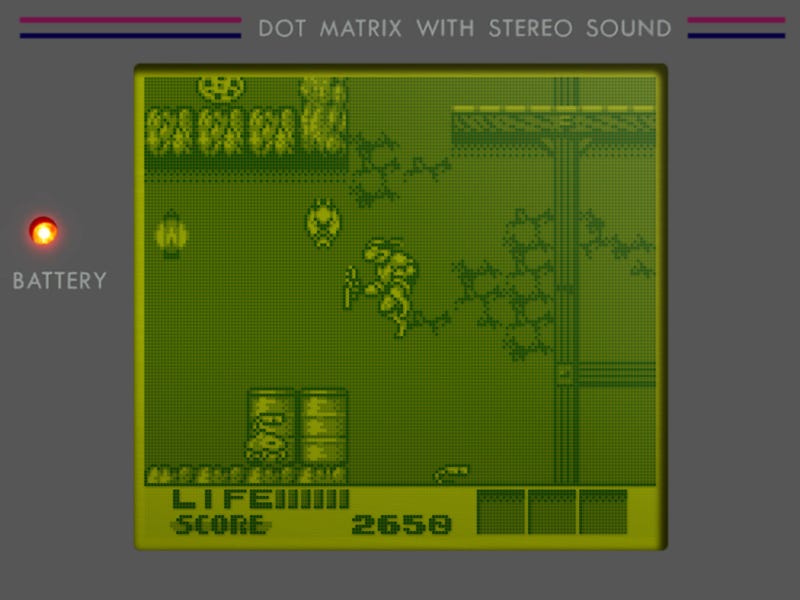
Play it on: Game Boy, Cowabunga Collection
I’m so glad that last year’s Cowabunga Collection has made this 1993 Game Boy game readily available again. The moment-to-moment gameplay doesn’t feel as fluid as it does in the Turtles’ great beat ‘em ups; if anything, it’s fairly stiff. But Radical Rescue makes up for that by offering different pleasures, putting a Metroidvania twist on the typical Foot Clan butt-kicking.
You start as Michelangelo, his brothers kidnapped, and must explore the compound where Shredder’s stashed ‘em. Each bro has a unique ability that allows access to otherwise unreachable areas, which naturally becomes vital in rescuing your kidnapped friends (Splinter and April have also been nabbed) and taking the fight to Shredder. Mikey can spin his nunchucks like a helicopter to glide across distances, Leo can drill the floor, Raph can squeeze through small passages and Donnie can climb walls.
Shredder’s hideaway is filled with all the classic 2D dangers—spiky balls of death, flame-spouting geysers, you name it—and the environments range from industrial warehouses to moody caverns as you venture deeper into the lair. Hot Konami jams provide the soundtrack to your adventure, and using each turtle’s unique abilities to overcome different obstacles lends the whole thing a real teamwork vibe. In a video game franchise dominated by brawlers, Radical Rescue is a refreshing change of pace for the heroes in a half shell. — Carolyn Petit
Teenage Mutant Ninja Turtles: Shredder’s Revenge

Play it on: PS5, PS4, Xbox Series X/S, Xbox One, Switch, Windows, Linux
There aren’t many games that lovingly recreate the vibe of yesteryear while maintaining a modern feel, but Tribute Games’ TMNT: Shredder’s Revenge does that with aplomb. A 2D side-scrolling brawler that takes plenty of inspo from Konami’s TMNT beat-em-ups (particularly 1991’s Turtles in Time) Shredder’s Revenge is a blast from the past in the best way possible. With all four Ninja Turtles at your disposal—alongside playable characters like Casey Jones, April O’Neil, Master Splinter, and more via DLC—you and some friends (in local or online co-op) go around beating the brakes off Foot Clan and various iconic villains to save New York City from chaos.
It’s a pretty basic narrative setup that gives way to a fighting game that feels and looks as retro as it does modern. From the Turtles’ personalities shining through the vivid pixel art to the crunchy combat that gives the characters some heft, Shredder’s Revenge leans into nostalgia while carving out its own identity, adding upgradeable stats and unlockable moves to add more depth to combat throughout one, or multiple, playthroughs.
Sure, the core concept—moving from left to right, pummeling goons till you make it to the boss, rinse and repeat—might grow stale across the game’s 16-level campaign, but the execution is so skillful that the sameness is never much of a deterrent. It’s like the most basic meal prepared in the best way. In that regard, Shredder’s Revenge is truly dope. — Levi Winslow
TMNT (2007)

Play it on: GBA
Before there was Shredder’s Revenge there was TMNT for the Game Boy Advance. One of the last great games to arrive on Nintendo’s handheld during its chaotically brief lifecycle, it was easily confused with the other game by the same name released in the same year for half a dozen other platforms, including the PlayStation Portable and Nintendo DS. Both were licensed movie tie-ins timed for the Turtles’ return to the big screen, but one was garbage and the other wasn’t.
While both were made in Ubisoft Montreal, the GBA game was a side project that ended up forming the pixel art brawler blueprint for gems like Scott Pilgrim vs. The World. TMNT married the twitchy satisfaction of Konami arcade beat ‘em ups with the combo depth and RPG-lite mechanics of the River City Ransom games. It’s a formula some of its developers, who went on to form Tribute Games, later perfected with Shredder’s Revenge. But nothing can ever replace the vibrant retro charm of this outing’s GBA aesthetic. — Ethan Gach
Teenage Mutant Ninja Turtles: Tournament Fighters (SNES)

Play it on: SNES, Cowabunga Collection
Versus fighting games became a 16-bit console staple in the wake of Street Fighter II: The World Warrior’s global success. Most paled in comparison to the king, but a bunch were fun, and a few were actually legit decent fighting games. Konami’s Teenage Mutant Ninja Turtles: Tournament Fighter was one such standout.
The SNES version, anyway. While games with the same name hit both NES and Genesis, the three were all completely unique, and wildly varying in quality. The SNES Tournament Fighters is the one folks still enjoy today, because unlike the other two, it does a pretty darn good job of being a TMNT-flavored version of Street Fighter II, which was harder to pull off than you’d think back then.
Make no mistake, Tournament Fighters is still a kusoge-adjacent console fighter at heart, featuring goofy junk like touch-of-death combos, janky exploits, and unevenly powered characters. But the bones here are good, competent in a way that they weren’t in so many other 16-bit wannabes. It has as an interesting cast, 2-in-1s, a legit combo engine, and even arguably the first example of a “super meter” that powers ultimate moves (it beat Super Street Fighter II Turbo to the punch by two months).
The surprisingly solid action and strong Konami aesthetics put the SNES version of Tournament Fighters in elite company, rubbing elbows with later high-end 16-bit attempts like Bishōjo Senshi Sailor Moon S and Gundam Wing: Endless Duel. Aside from official Street Fighter and Mortal Kombat ports, cartoon-licensed games like these were as good as home fighters would get until Sony PlayStation and Sega Saturn started to truly bring the arcade experience home in the second half of the ‘90s.
Such is the fondness for Tournament Fighters that fans are even working on a Championship Edition hack that aims to add quality-of-life features and eventually some rebalancing. It’s a rare game that enjoys such reverent treatment nearly three decades after release. — Alexandra Hall
Teenage Mutant Ninja Turtles: Splintered Fate
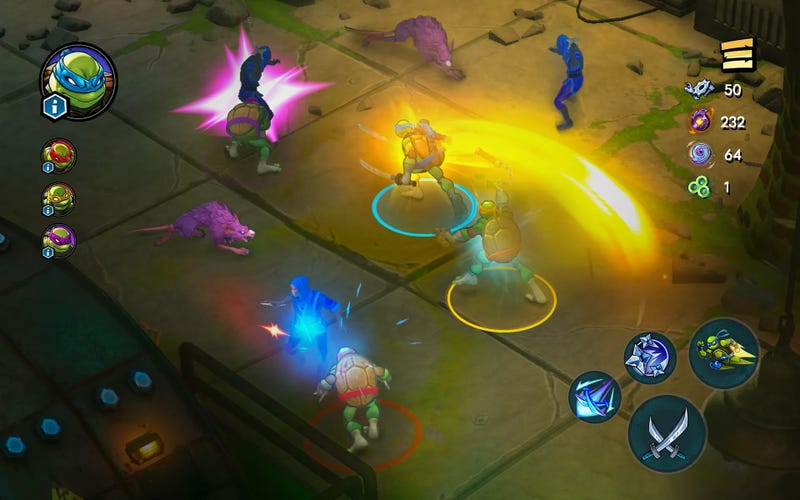
Play it on: iOS
Hades is a very good game. People love it. But you know what the popular top-down roguelike action game was missing? Teenage Mutant Ninja Turtles. Well don’t worry, TMNT: Splintered Fate—released in 2023 on Apple Arcade—is here to fix that problem. And not only is it a solid Hades clone, it’s also a damn fine game on its own.
In Splintered Fate, the Turtles are shocked when their master, the mutant rat Splinter, is kidnapped (guess they haven’t played their other video games). Together, the four Turtles have to work together to take on randomly generated levels and collect various power-ups, making progress toward solving the mystery behind who took their rat dad and why.
While most TMNT games are 2D, side-scrolling brawlers, Splintered Fate plays more like Hades or Diablo, letting you see more of the action and making the Turtles feel a bit more powerful and radical. And because it’s on Apple Arcade, there are no microtransactions or other annoying instances of free-to-play bullshit to ruin the fun. Just you picking your favourite turtle—each with their own moves and abilities—and completing runs to earn resources that let you slowly upgrade the famous ninjas into deadly warriors. It might be new, it might be different than other TMNT games, but don’t sleep on Splintered Fate. Especially if you’re a big fan of Hades. — Zack Zwiezen
Teenage Mutant Ninja Turtles (NES)
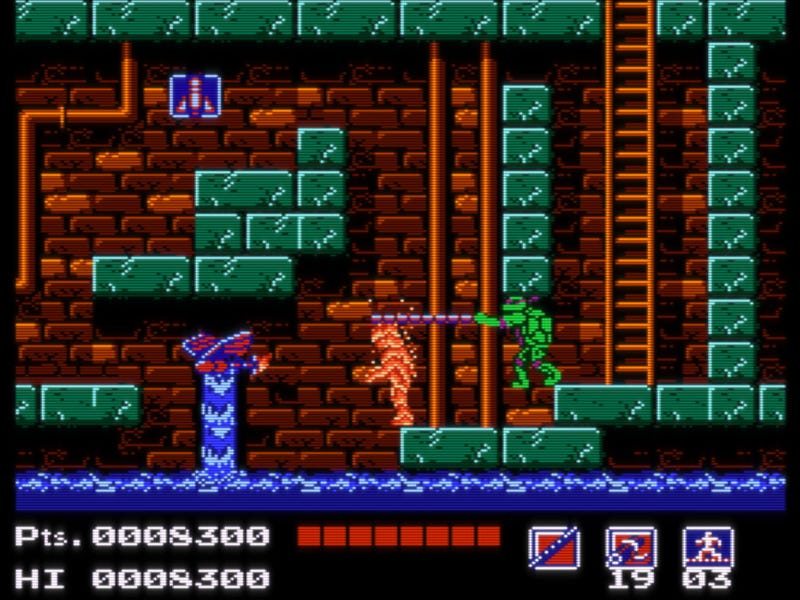
Play it on: NES, Cowabunga Collection
Though it was a huge success at the time of its release, many now consider the very first TMNT video game, released by Konami for the NES in 1989, to be a bad game. In particular, its second stage, in which you must swim and defuse bombs set to blow up a dam, has been memed to hell and back as an example of bad game design and absurd difficulty. And I guess I can see how, in retrospect, the beat ‘em ups that followed seem like such a better, more natural fit for the Turtles, which can make this game look misguided in its approach to building a game around them in comparison.
But I will defend this game. Sure, it’s “flawed”…a lot of really cool, interesting games are. It also has ideas, and the way it incorporates exploration and shifts in perspective between top-down navigation and side-scrolling platforming help it feel like a real adventure, and not just a sequence of stages. As great as the beat ‘em ups are, I’d argue they also resulted in a kind of flattening in TMNT game design, establishing the “one true template” for Turtles games and making quirky games like this one a rarity.
Perhaps my favourite quirk is just how incredibly OP Donatello, with the absurdly long reach of his bo, can feel at times, and conversely, how ineffectual Raphael (my favourite turtle), with his short-range sai, can be in many of the game’s situations, leading to meta-strategies where it sometimes became smart to use him as a kind of sacrifice turtle, eating damage with Raph to keep the others healthy and safe in your inventory. It was a game made long before the current obsession with “balance” became a thing, and I think it’s better and more interesting for it. Also, I’m sorry, but that dam level is just not that hard. Get over it. — Carolyn Petit
Teenage Mutant Ninja Turtles IV: Turtles in Time (SNES)
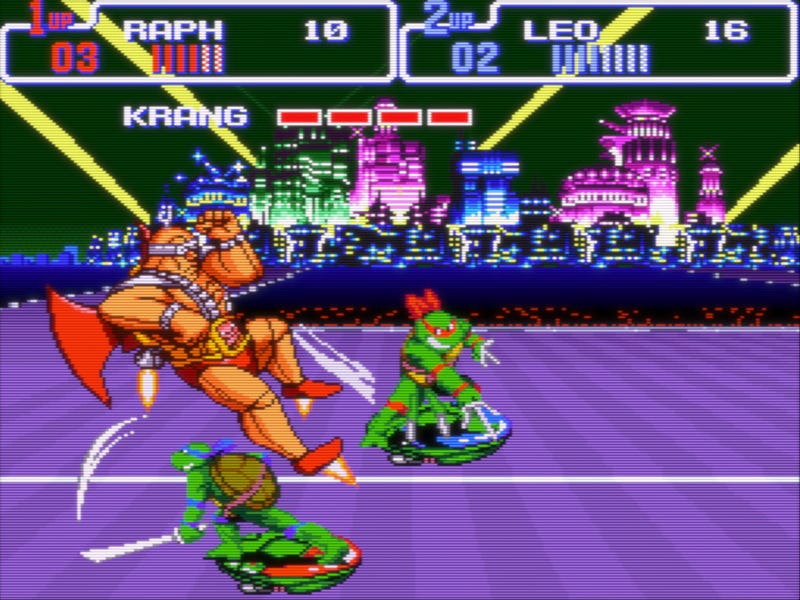
Play it on: SNES, Cowabunga Collection
Some things hit at just the right time and place and are forever after cemented into the Mount Rushmore of gaming. Turtles in Time, first in arcades and then on SNES, improved on everything about Konami’s earlier arcade and NES Turtles brawlers without bogging its action down in gimmicks or extra baggage. Leo and co. go from the streets of New York City to prehistoric times to Blade Runner dystopia, stopping at pirate ships and wild west saloons along the way. It’s extremely kitschy in a way that could only work in the ‘90s, helped out by some of the brightest greens, yellows, and purples you’ll ever see on a CRT.
While vehicle levels made use of the SNES’s Mode 7 graphics to provide multi-layered depth, it’s picking up foot soldiers and smashing them into the screen that everyone remembers. In earlier games it was a random treat. Turtles in Time made it an actual mechanic, and one players were required to perfect in an innovative fight against Shredder in the Technodrome where he’s piloting a mech. This excellent home port is still one of the essential SNES games. — Ethan Gach
Teenage Mutant Ninja Turtles: The Hyperstone Heist

Play it on: Genesis, Cowabunga Collection
You can’t throw enemies out of the screen in The Hyperstone Heist, the Sega Genesis’ answer to Turtles in Time, but you do get a dedicated dash button and punchier gameplay. What it lacks in the number and variety of levels it makes up for with longer, more detailed side-scrolling environments and better graphics.
Hyperstone Heist has long struggled to get out from under the long shadow cast by Turtles In Time, but it’s far more than just a clone. Even if it begins like the SNES game with Shredder making the Statue of Liberty disappear, and ends with a familiar showdown against the Foot Clan boss, it has its own subtly distinct flavor and texture. There aren’t as many unique voiced lines, cameos, or Easter Eggs from the Turtles universe, but its fast-paced boss rush structure is everything you could want from a ‘90s beat ‘em up. And if you were a Sega Genesis kid, it was just obvious that it was way better than Turtles in Time. — Ethan Gach
Those are our picks for the best TMNT games! Did we catch all your favourites? Which other games would you recommend?
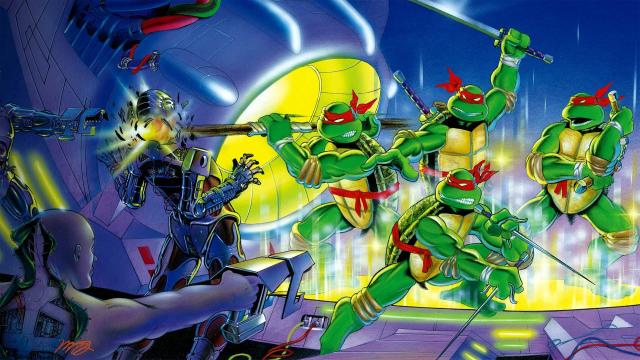
Leave a Reply